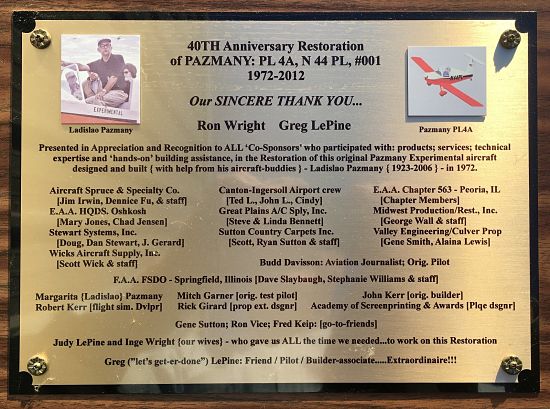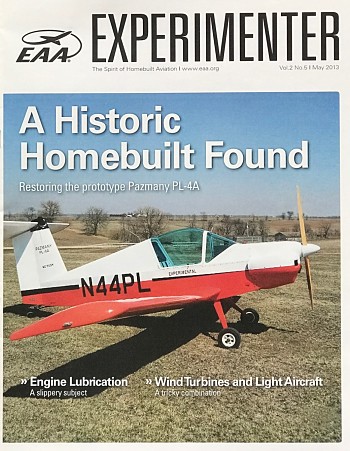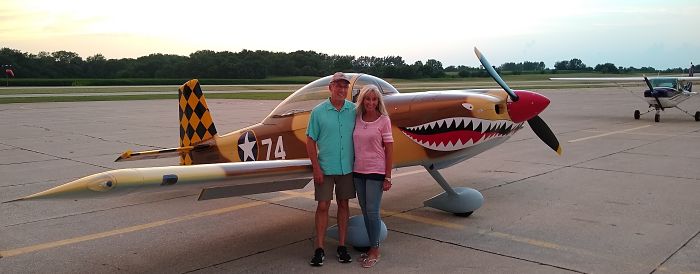
The Beacon
August 2021
Chapter

The first breakfast in July attracted three airplanes including a gorgeous RV-14. Jason Presley, the first to complete at Ray Scholarship at the chapter, was also present. The group broke up before before a meeting could be called to order, but a News from HQ and a Hints for Homebuilders video were played for the few members who remained. HQ mentioned the AeroEducate program, for youth who have taken a Young Eagles flight, is nearly ready; it was first announced back in January. The Hints video covered making an oven to accelerate the curing of fiberglass parts. A simple box of foamboard receives a heater, such as an incandescent light bulb or a small ceramic heater, driven by a temperature controller like those from InkBird. The August chapter meeting is next Saturday at 9:15.
A nominating committee to select a slate for next year is being formed. If you'd like to serve on the chapter board, please contact the chapter president.
Unable to find enough time, Ian Kempf resigned his position on the board. The president nominated Josh Mattson to replace him, and the board has approved this change.
Arrangements for our Annual Banquet have already been made. It will at held at the Lariat Steakhouse on Glen Ave., Saturday December 18. Four different meals (steak, fish, chicken, pasta) will be offered.
OSH
HQ is purging the old, paper records held for each chapter. Chapters were invited to pick up their folder at Airventure, and Bill Larson has done so.
Tom O'Toole organized a chapter cook out at HQ's Chapters Pavilion, and a number of chapter members were able to attend that Thursday:
We had the cook out as planned. Kent and Justin were a great help with cooking the hot dogs and burgers. National was truly wonderful with accommodations. Several chapter members gathered and talked about the airshow as well as last night's storms.

The young couple in the group photo are Peter and Barbara from Poland. You'll find Peter at the 3MY fuel pump now and then, refilling either a Cessna 150 or one of the three Robinson helicopters stored in the same hangar. He's a member of an EAA chapter in his home country.
Youth Programs

Jolene Miller, the chapter's Ray Scholar for 2021, was at Airventure when she sent along this update:
Hey all! This summer has been very busy for me, but that hasnít stopped me from flying as much as possible. I have officially completed all of my XC solo requirements! I feel that I am in such a fun and exciting part of my training now! The last few days, I have been on a much needed vacation, starting in Oshkosh, Wisconsin for Airventure! By the time this is published, I will be in Florida. When I get back, I will be scheduling my written test. After I take my written (and hopefully pass 😀) then I will be focusing all of my time building solo hours and doing check ride prep with my instructor! I am getting very close to the end, and I am so excited!!
VMC and IMC Club
Following the required training from HQ, Karl Kleimenhagen has officially taken over duties as the VMC Club coordinator. In addition to the usual Pilot Workshops video each month, we'll be trying again the topics suggested by HQ, at least for a while. This month's meeting was the week before the Chapter Meeting, so the next meeting is September's.
The IMC Club meets next Sunday, 8/8 in the hangar at 6:00.
Mountain Flying
The July IMC Club meeting started with an interesting, hour long presentation by Bill Hurley on his June flight to Yakima, WA, one he called a "Bucket List flight."
Planning for this adventure began by consulting with a CFI in the Galesburg area who had time in Colorado. The instructor's advice was to fly in the mornings to have lower density altitudes and don't fly in mountains if the winds aloft are over 30 kt. Bill studied the density altitude performance charts for his airplane, a Cessna Cardinal with 180 hp and a CS prop, and decided a route which minimized altitude was in order.
It's 1350 miles to Yakima. Although rated for IFR, he chose to fly mostly VFR, to give an extra margin of safety in the mountain passes. Alternate airports out West are usually over 40 miles away, and with proper IFR fuel reserves, his Cessna could plan for about 3 hour legs. Dial in the headwinds typically found for the route, and one ends up with rather short IFR legs.
The maps were studied to select a route with airports at lower elevations and spaced about 300 miles apart. He also wanted runways at least 5000 ft long, preferably with a second runway should heavy crosswinds be encountered. Splitting the trip in to two days allowed him to enter the mountainous portion in the morning. The route selected was south of a straight line to Yakima. Studying the weather in the preceding weeks, he found the northern routes more prone to storms, and at that time there were many TFR's due to forest fires. Foreflight also alerted him to rapid temperature drops with altitude, a good sign of heavy turbulence in the mountains. He phoned airports along the way to ask for advice, and they, too, warned of high winds after noon. Bill brought along, of course, an emergency kit with plenty of water.
The route planned had no more than 10,000 ft MSL and 3,000 AGL, and the maximum airport elevation was 6,700 ft, at Rock Springs, WY. When he arrived at Rock Springs, the density altitude was 9,000 ft, and even with a CS prop he needed 3,000 ft to get the mains sluggishly off the ground. At 300 lb under gross and the engine properly leaned, the Cessna was good for only 300 fpm.
From Rock Springs the next stop was just west of Boise. From there he planned to fly up a valley towards La Grande, ID, but weather reports lead him to try the next valley west. Weather moved into this valley during the flight, and while he then tried the original valley, a wall of weather there would have forced him IFR, so he returned to the Boise area. There he received advice to head further west before turning north, which proved correct. It made for a long day.
Once at his destination, he was able to enjoy a drive in the Cascade mountains, which he feels must be one of the grandest mountain ranges he's done. He also toured the Cub Crafters factory in Yakima. Unique among Cub style airplanes, they use push-pull rods instead of cables, giving a very nice feel to the controls. Also unique is the available tricycle gear, which offers slightly improved landing performance in competitions, given its ability to mash down on the brakes upon landing.
The return trip offered a strong tailwind, with ground speeds over 165 mph. With the fires down, he chose a more northerly route, along some of the Columbia River watershed. As he approached Lewiston, ID, Flight Following asked him to listen for ELT transmissions, which he did encounter and reported. Search planes were soon on it, and he later learned two fliers were rescued from the rough terrain to the south of his route.
Soon after, he noticed his fuel readings were unexpectedly low, and not wanting to employ his own ELT, chose to ask for an expedited approach to the next airport. It turned out one tank's vent line had plugged leaving it unable to deliver fuel at the proper rate. The friendly local FBO blew out the lines before he continued on to Illinois.
Hangar
A WiFi connected printer has been added to the hangar. You can print to it from your smartphone, tablet, or laptop.
The most recent addition to the chapter tool crib is a set of electronic scales which can be used to measure the weight and balance of your airplane. Designed to weigh cars, it includes four load cells each with 2000 lb capacity. It was purchased used, and the plan is to recoup part of this cost by asking a $25 rental fee to anyone, chapter member or not, who wishes to use it.
For Sale
Among the items recently added to the For Sale page are a Cessna 150, Cessna wheels and brakes, and Lycoming and Continental starters.
Members
Vince Stubbs is the newest member of the chapter.
Projects
Greg LePine
With help from four chapter members, Greg's scale F4U was moved from its assembly bay and positioned near the door. Final details both under the cowl and with the wiring were being done as this was published, with first engine start coming soon.

Karl and Kip Kleimenhagen
Assembly of our RANS S-20 fuselage kit had been going well enough until the baggage bay was reached. The old nemesis of incorrectly sized parts from the factory resurfaced. 😖 The shear at the hangar made easy work of the oversized bottom sheet, but the back and side sheets are undersized. Leaving gaps in the overlap at the corners and at the fuselage tubing ain't pretty but allowed us to proceed. The floor of the baggage bay was a bit too flexible, but stiffening ribs made from scrap found under the shear were quickly formed, using the shear and brake. The factory's recommendation for routing the pitch trim servo wire was impractical, and an alternate was worked out. There's one more bay to fit, then it's on to covering the fuselage—over a month behind this year's schedule.
Rob and Jeff Meyer
Rob Meyer's Zenith 750 Super Duty kit had been nearly without flaws up until he began construction of the leading edge slats. When Zenith was told the completed slat wouldn't fit the wing, they sent another slat kit. When that, too, didn't fit, they looked into it and realized they were using the wrong forming tool for that particular slat. Yet another slat kit should show up. The only other disappointment has been the factory has yet to release the drawings for this model. All other Zenith models include fully dimensioned drawings, something almost unique now in the industry.
Josh Mattson
Josh mentioned he's nearly finished tearing down the Pazmany PL-4 project he took on and is looking forward to building it back up. Removing the ill advised modifications made in the initial build has proven more involved than the first estimate. Josh is a newly minted A&P mechanic, and is also the newest chapter board member.
The Wright Stuff
The second installment of this recounting of the restoration of the original Pazmany PL-4A was in last month's news, where Ron described the work which would be required to restore the airplane. Ron concludes the story this month:
So, we came up with the idea to tell everyone about this very special aircraft restoration project and to solicit their help in an effort to assist us to do all that we wanted to do to restore this project back to its original condition to include some modernization along the way.
Who was it that said: "Ask and you shall receive? Amazingly, as Greg and I began to spread the word about what we were planning to do to restore the Paz, the generosity of a multitude of folks, who became as excited about this restoration project as Greg and I had become, began to contribute what they could, be it money, service, their time, and even parts! In total there were 21 benefactors who participated in the overall restoration of this historic and unique aircraft. Each participant received a Plaque of Appreciation in recognition of their assistance to help us complete this project. Our EAA Chapter 563, who was a significant sponsor, has it's plaque displayed on our Wall-of-Fame in the hangar.

So, with unrelenting dedication, Greg was on duty working on this project every day plying his magic, willing this plane to become reborn again, which it did, eventually! Because the designer, Ladislao, was an educated Aeronautical Engineer, and his day job was designing and building American military aircraft, his talent and knowledge was infused into all his experimental aircraft designs, and they were all way overbuilt when compared to what was being designed by other experimental aircraft designers during that period of time. Because of his design commitment, I know that an unforeseen, "off airport arrival" I had to make during one of my Flight Evaluation sessions, which resulted in a non-repairable condition to the Paz, actually protected me from receiving more injury than I would have received had I been flying a different brand of airplane.
Flying the Paz was always an enjoyable experience. The control responses were solid, precise, and stable. Stalls were never abrupt, and recovery was by-the-book. This aircraft was not aerobatic but always wanted to be! Visibility was excellent; I could imagine that I was flying in a fighter aircraft because it always wanted to fly like one. A unique feature with this model of Paz was that it could be built with a folding wing feature not unlike the current line of a Onex experimental aircraft. Ironically, the beautiful 1/2 scale Corsair that Greg has built has a very unique wing folding design not unlike that found in the Paz that Greg worked on. Hmmm, wonder where Greg got the idea to make his wings fold like that. I'll never tell!
As perhaps a fitting tribute to this Paz, I donated most of it's remains to the A&P training facility, in Springfield to be used as a training unit for their students so they have an opportunity to work-on an Experimental aircraft as well as Certified aircraft to help them understand something about the World of Experimental aircraft.
And, it's refreshing to see that another Pazmany PL-4A is under restoration in our Chapter hangar. Let's Keep 'em Flying!

Editor's note: More information on this restoration project can be found in the May, 2013 issue of EAA's Experimenter magazine, which is available to EAA members in the print archives section of the EAA web site. The NTSB accident report notes the propeller speed reduction unit failed, in part due to a lack of documentation for its installation.
Airport
3MY
Beginning Tuesday morning, the runway and taxiway lines will be repainted. The runway will be closed for about a half day.
An early evening stop by 3MY found a fancifully painted RV-8 refueling. The owner, Carl Schmidt, was stopping overnight before finishing his flight to OSH from near Atlanta. He's a friend of chapter member Kathy Arkwell, who posed with him for the photo. Carl said he's not the only Delta pilot who keeps an RV for fun; there are about another 50 or so at his home field.

It was Cirrus Day at Mt Hawley in early July. Pilots must have been in for a Cirrus seminar of some sort.








